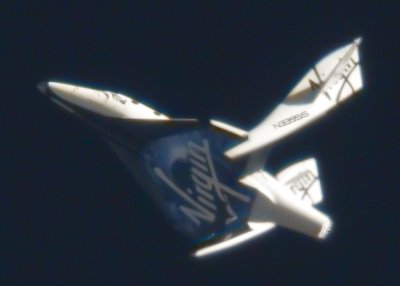
SpaceShipTwo during the feathered portion of a glide flight last week. (Clay Center Observatory/Virgin Galactic)
For some time, a long pause in glide tests of Virgin Galactic’s SpaceShipTwo raised questions about the progress the company was making, in partnership with Scaled Composites, on development of suborbital spacecraft. After a January 13th glide test, the fourth overall for the vehicle, more than three months elapsed without another (although attempts to conduct a glide test in mid-February were aborted due to poor weather conditions, according to Scaled’s flight logs.)
That’s changed, though, in a big way. In less than three weeks, Virgin and Scaled have doubled the number of glide flights of SpaceShipTwo, with four flights between April 22 and May 10. Those flights included glide flights of longer duration on April 22 and 27, followed by the first flight of SpaceShipTwo that tested the vehicle’s ability to “feather” its wings, on May 4. That feathering, like that used on SpaceShipOne, rotates the tail section to a 65-degree angle, and is intended to provide for a stable reentry of the vehicle on suborbital spaceflights. On last week’s test, SpaceShipTwo flew in the feathered configuration for about 75 seconds before rotating the wings back to their normal configuration for landing.
Scaled and Virgin followed up that test with another glide test, this time without feathering, on Tuesday. That test was designed to perform testing on “flutter susceptibility” and also pilot proficiency, according to the flight logs. Why this sudden surge in testing isn’t clear, nor is there any indication from the company when they’ll be ready to start powered flight tests of SpaceShipTwo.

Leave a Reply